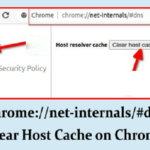To reduce website loading issues, by looking at old pages, or checking network errors in Google Chrome, cleaning DNS cache can be solved in simple stages. When we are browsing the Internet, your browser needs to translate the website names into an IP address – a process known as the Domain Name Resolution (DNS). To help with it, Google Chrome now has its own underlying tool known as a net internal. This tool is ideally suitable for developers and IT teams, as it shows details about how Google Network Connection, especially DNS (domain name system). But the question is how it acts and here we are taking you through Chrome Net Internal DNS!
What is really Chrome Net Internal DNS?
Net internal is a device powered by DNS Google Chrome that provides a detailed view of the DNS operations and functions of the browser. However, it also provides direct management of DNS-related settings. It is an important tool that provides a diagnosis and solution to any DNS problem that can turn it into decreasing speed or errors when reaching websites. Meanwhile, it is mainly used on chrome that is a suit of network analysis solutions such as Microsoft Edge and Opera. Users can only use the DNS settings section by providing Chrome Net Internals DNS on the search bar of Chrome, where you will get all the stored DNS data.
How to clean DNS cache in Google Chrome using “Net Internal DNS”?
Follow the instructions below hosting cache to clean your Google Chrome browsers quickly.
Step 1: Paste the net internal command in Google Chrome
- Open Google Chrome on your desktop computer or laptop.
- Enter or copy Chrome: // NET-Internals/DNS in the URL bar and paste it and hit the enter.
- This Chrome internal network will bring diagnostics page where you can control DNS cache and other network-related settings.
Step 2: Empty Host cache
- Tap the next host cache button for host resolution cache text.
- By doing this you can make sure that the next time you visit a website, Chrome will lookup new DNS.
Step 3: To flush the socket pool
- It is advisable to flush the socket pool not to reuse the chrome connection after cleaning the DNS cache that has DNS records out-of-date records.
- Just copy and paste the command chrome in the top URL box: // Net-internal/sockets or select the socket option from the left-side bar.
- Now select the button to flush the socket pool.
- All active network connections will be discontinued as a guarantee that no connection will maintain old DNS information before the latest lookup.
Step 4: Restart chrome
- Chrome now restart.
- Any remaining temporary data is re -removed and all changes are guaranteed to be effective.
- Chrome will after completing these steps will make up new DNS looks for every website you see, which can fix the problems brought by out-of-date or corrupt DNS cache entries.
How clear is DNS cache with DNS Net Internal on Mobile?
This tool acts as a top level diagnostic tool for mobile devices, which cleans DNS cache data on all Android iPhones and iPad platforms. When using Chrome’s net-internal DNS, there is confusion on mobile devices when the host cache is removed. The solution to this problem becomes straight and unrestricted.
Users can activate the chrome browser to clean the host cache on your Android iPhone or iPad smartphone and navigate on Chrome: // Net-Internal/DNS. These steps take to clean the cache.
Step 1: Launch Chrome.
Step 2: Click on the excess button located in the upper right corner of the performance.
Step 3: Select history by tapping on it in the list.
Step 4: Now choose the deadline or click all the time to remove all browsing data.
Step 5: Turn on cookies and site data and cache images and files.
Step 6: Select the clear data button located on the bottom of the panel.
Reset Google Chrome cache
Resetting the chrome flag is the ultimate technique. Google Chrome is experimenting with these features. They are closed by default. You can enable it for test purposes. Just take these simple steps.
Step 1: Launch Google Chrome
Step 2: Press the flag in the address bar: // flags and enter.
Step 3: See and click on all reset on the default button on top of the page.
Step 4: After that a screen prompt is asking to confirm the reset. reset all.
Step 5: Your reset will end at this point. You will be asked to restart the chrome. This will make modifications effective.
MacOs DNS Cache Clear
Step 1: Type the terminal in the spotlight.
Step 2: Open the terminal window and enter the command.
Flushing on DNS Cache Linux
These steps will help you clean the net internal DNS cache on Linux quickly.
Step 1: Open the Linux System Terminal.
Step 2: Type Sudo Systemd-Resolve-Flush-Caches and press Enter.
Step 3: It will clean the DNS cache of both positive and negative entries.
Step 4: Enter the Sudo Systemd-Resolve-Statistics and press Enter to confirm the cache clearing. The data related to DNS questions that have been solved will result in consequences.
When DNS cache is not working, tips to use
Sometimes using Chrome: // Net- Internals/DNS to clean chrome’s DNS cache does not work immediately or you can still walk on issues where websites are not loaded after completing the process.
Try to restart Chrome Net Internal DNS Clear Host cache button itself to restart Chrome browser itself.
- Sometimes resetting your computer or mobile device makes the system-level problems completely fix when continuing the problem.
- As earlier, another required step was mentioned that the out-of-date DNS data is completely eliminated, the system is cleaning the DNS cache.
- Finally you can find out if a browser extension is interfering in the DNS management process using the secret mode of chrome.
- Try to close each of your extensions at once to find a source of problem if it does not occur in secret mode.
- If a website still does not load the DNS cache in Chrome, then you should first check your internet connection.
When to clean the DNS cache in Google Chrome?
If you experience any of the following then you want to clean the DNS cache. Chrome is having trouble loading a website that you know is live.
Even if you know that the website has been updated, you are still looking at an old version of it. DNS_Probe_finished_nxdomain like DNS-related errors are happening for you.
Ever since you have switched a network switch or changed your DNS settings, you have been having problems reaching websites.
Since Chrome is performing the new DNS lookup, cleaning the cache is a safe troubleshooting step with some problems, although you can see a slightly slow website load time on your first trip.
Final idea
A quick and efficient solution for a lot of common browsing problems such as inaccessible websites or out-of-date content is to clean the DNS cache in Google Chrome. If you follow the above instructions for net internal command host cache clearing and socket pool flushing, Chrome will now use the most recent DNS information.















